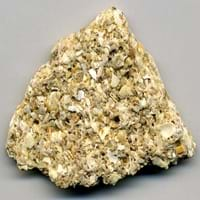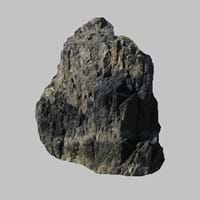Coquina and Cataclasite
Definition
Definition
Coquina is a sedimentary rock that is composed either wholly or almost entirely of the transported, abraded, and mechanically-sorted fragments of the shells of molluscs, trilobites, brachiopods, or other invertebrates
Cataclasite is a type of cataclastic rock that is formed by fracturing and comminution during faulting. It is normally cohesive and non-foliated, consisting of angular clasts in a finer-grained matrix
History
Origin
European Foreland Basins
Swiss Alps, Europe
Discoverer
Unknown
Michael Tellinger
Etymology
From Concha (Latin)+ Coquina(Spanish) +conch(English)= Couquina (mid 19th century)
From the Italian word cataclasi
Class
Sedimentary Rocks
Metamorphic Rocks
Sub-Class
Durable Rock, Soft Rock
Durable Rock, Medium Hardness Rock
Family
Group
Not Applicable
Not Applicable
Other Categories
Coarse Grained Rock, Opaque Rock
Fine Grained Rock, Opaque Rock
Texture
Texture
Clastic
Clastic
Color
Beige, Buff, Orange
Brown, Green, White, Yellow
Maintenance
More
Less
Durability
Non-Durable
Durable
Water Resistant
No
Yes
Scratch Resistant
No
No
Stain Resistant
No
No
Wind Resistant
No
No
Acid Resistant
No
No
Appearance
Layered, Banded, Veined and Shiny
Dull and Banded
Uses
Architecture
Interior Uses
Decorative Aggregates, Homes, Hotels, Interior Decoration
Decorative Aggregates, Homes
Exterior Uses
Garden Decoration, Office Buildings
As Building Stone, As Facing Stone, Paving Stone
Other Architectural Uses
Curbing
Curbing
Industry
Construction Industry
Building houses or walls, Construction Aggregate
As Dimension Stone, Building houses or walls, Cement Manufacture, Construction Aggregate, for Road Aggregate
Medical Industry
Not Yet Used
Not Yet Used
Antiquity Uses
Artifacts, Monuments, Sculpture, Small Figurines
Artifacts
Other Uses
Commercial Uses
Creating Artwork
Commemorative Tablets, Creating Artwork
Types
Types
Not Available
Protocataclasite, Mesocataclasite, Ultracataclasite and Foliated cataclasite
Features
Available in Lots of Colors and Patterns, Is one of the oldest rock
Easily splits into thin plates, Is one of the oldest rock
Archaeological Significance
Monuments
Used
Not Yet Used
Famous Monuments
Data Not Available
Not Applicable
Sculpture
Used
Not Yet Used
Famous Sculptures
Data Not Available
Not Applicable
Pictographs
Used
Used
Petroglyphs
Used
Used
Figurines
Used
Not Yet Used
Fossils
Present
Absent
Formation
Formation
Coquina is a sedimentary rock which is formed when billions of small clam-like seashell, called Coquina, or cockleshell are die and hence are deposited, buried and turns into a rock when pressure is applied.
Cataclasiste rocks mainly form by pressure deep under the Earth's surface, from the extreme heat caused by magma or by the intense collisions and friction of tectonic plates.
Composition
Mineral Content
Apatite, Augite, Bronzite, Calcite, Chert, Chlorite, Clay Minerals, Epidote, Feldspar, Garnet, Micas, Muscovite or Illite
Albite, Apatite, Augite, Biotite, Calcite, Enstatite, Epidote, Feldspar, Micas, Muscovite or Illite, Pyroxene, Quartz
Compound Content
CaO, Carbon Dioxide, Iron(III) Oxide, MgO
Silicon Dioxide
Transformation
Metamorphism
No
No
Types of Metamorphism
Not Applicable
Not Applicable
Weathering
Yes
Yes
Types of Weathering
Biological Weathering, Chemical Weathering, Mechanical Weathering
Mechanical Weathering
Erosion
Yes
Yes
Types of Erosion
Coastal Erosion, Sea Erosion, Water Erosion, Wind Erosion
Coastal Erosion, Wind Erosion
Properties
Physical Properties
Hardness
1-2
3-4
Grain Size
Coarse Grained
Fine Grained
Fracture
Irregular
NA
Streak
White
Black
Porosity
Highly Porous
Less Porous
Luster
Dull to Vitreous to Submetallic
Vitreous
Cleavage
Not Available
Not Available
Toughness
Not Available
Not Available
Specific Gravity
1.10-2.24
2.1
Transparency
Opaque
Translucent to Opaque
Density
2.8-2.9 g/cm3
2.9-3.1 g/cm3
Thermal Properties
Resistance
Heat Resistant, Impact Resistant, Pressure Resistant, Wear Resistant
Heat Resistant, Impact Resistant, Pressure Resistant
Reserves
Deposits in Eastern Continents
Asia
Not Yet Found
China, India, Russia, Saudi Arabia, South Korea
Africa
Not Yet Found
Egypt, Ethiopia, Kenya, Madagascar, Morocco, South Africa
Europe
United Kingdom
England, Finland, France, Spain, United Kingdom
Others
Not Yet Found
Not Yet Found
Deposits in Western Continents
North America
USA
Canada, USA
South America
Not Yet Found
Argentina, Colombia
Deposits in Oceania Continent
Australia
Not Yet Found
Central Australia, Western Australia
All about Coquina and Cataclasite Properties
Know all about Coquina and Cataclasite properties here. All properties of rocks are important as they define the type of rock and its application. Coquina belongs to Sedimentary Rocks while Cataclasite belongs to Metamorphic Rocks.Texture of Coquina is Clastic whereas that of Cataclasite is Clastic. Coquina appears Layered, Banded, Veined and Shiny and Cataclasite appears Dull and Banded. The luster of Coquina is dull to vitreous to submetallic while that of Cataclasite is vitreous. Coquina is available in beige, buff, orange colors whereas Cataclasite is available in brown, green, white, yellow colors. The commercial uses of Coquina are creating artwork and that of Cataclasite are commemorative tablets, creating artwork.
|
||
|
||
|










